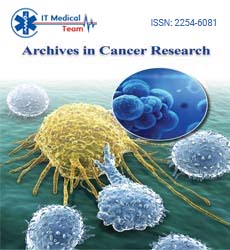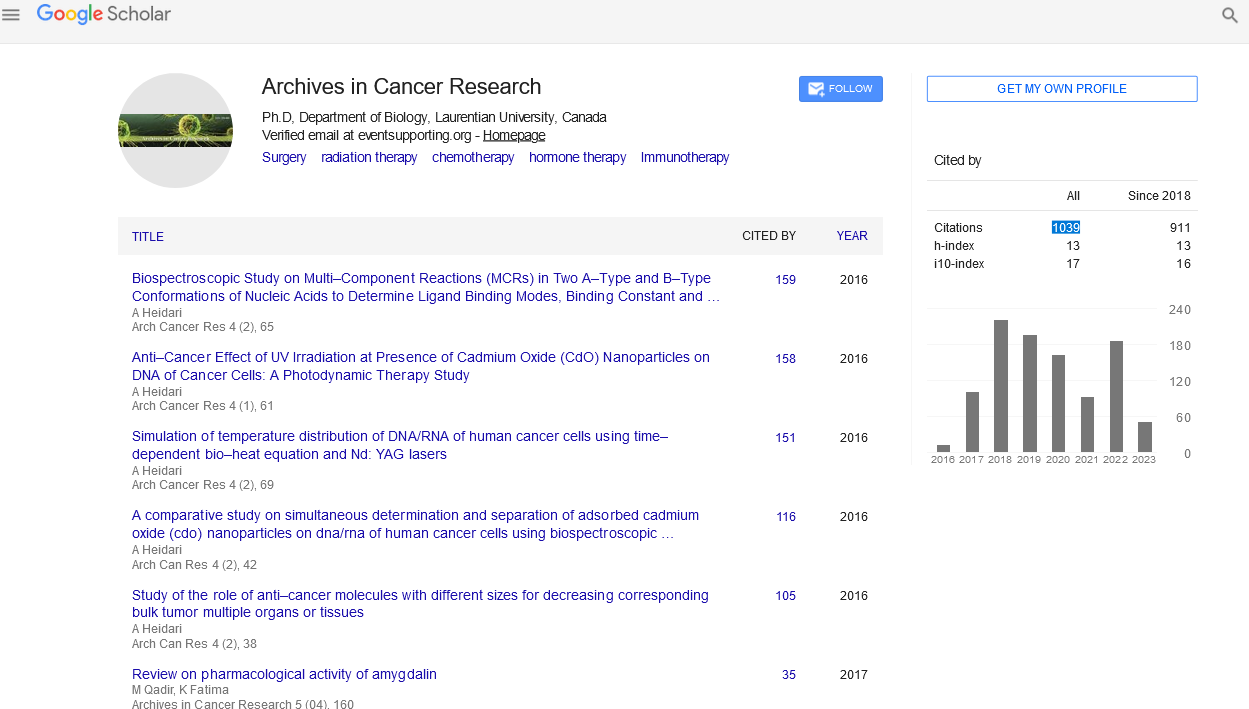Abstract
Cancer survivorship has remarkably improved over the past decades; all the same, cancer survivors are burdened with multiple health complications primarily caused by their cancer medical care. Therapy-induced senescence is recognized as a basic mechanism contributory to adverse health complications in cancer survivors. during this mini-review, we'll discuss the recent literature describing the mechanisms of cancer therapy-induced senescence. We’ll target epithelial tissue cell senescence since it's been shown to be a key player in various vessel complications. We’ll additionally discuss novel senotherapeutic approaches that have the potential to combat therapy-induced epithelial tissue cell senescence.
Keywords
Cancer therapy; Endothelial cells; Senescence Cancer; medical aid;
Anthracyclines; Radiation cardio-oncology
Introduction
Recent years have witnessed important enhancements within
the designation and treatment of cancer patients, resulting in a
motivating increase within the population of cancer survivors,
currently exceptional fifteen million within the consequently,
the semipermanent adverse effects related to cancer treatment
became progressively apparent. One in all those adverse effects
is that the accelerated aging and premature frailty iatrogenic by
cancer treatment. Indeed, when completion of cancer treatment,
cancer survivors seem to be twenty years older than their age
thanks to declining body reserves [1]. To boot, several cancer
treatments adversely have an effect on the circulatory system
and increase the susceptibleness of cancer survivors to develop
premature vessel complications. Though many mechanisms
are planned to elucidate the molecular mechanisms of cancer
therapy-induced vessel complications, the role of therapyinduced
premature aging in mediating these vessel complications
has recently been recognized.
Cellular senescence, one in all the hallmarks of aging, has been a
spotlight of cancer analysis over the past decade and was known
as a crucial mechanism of cell response to cancer treatments [2].
Intriguingly, sturdy proof reveals that ageing vessel cells play a
crucial role within the development of multiple vessel diseases
(CVDs) as comprehensively reviewed. Specifically, vascular
senescence has been known as a major contributor to multiple CVDs as well as induration of the arteries, high blood pressure,
and stroke. Multiple forms of cells are concerned in vascular
senescence as well as epithelial tissue cells (ECs), vascular swish
muscle cells, and epithelial tissue root cells.
This mini-review can target cancer treatment-induced epithelial
tissue senescence. First, we'll discuss however epithelial tissue
senescence contributes to various vessel health complications.
Then, we'll summarize and judge the in vivo and in vitro studies
demonstrating epithelial tissue senescence following cancer
treatment and describe the underlying molecular mechanisms.
Finally, we'll highlight novel senotherapeutic approaches that
have the potential to combat therapy-induced epithelial tissue
cell senescence and thence shield cancer survivors from vessel
complications.
Senescence has historically been thought of a state of irreversible
cell cycle arrest that happens in response to multiple stressors
eventually resulting in the loss of the replicative potential [3].
However, recent studies show that ageing cells will go into the
cell cycle below bound circumstances. Cellular senescence
plays physiological roles in embryonic development and wound
healing. To boot, senescence is a crucial protecting mechanism
to suppress growth following oncogenic activation. However
accumulating proof from in vivo and in vitro studies demonstrates
that persistence of senescence disrupts equilibrium and
contributes to aging. Indeed, cellular senescence is one in all the seven hallmarks of aging and contributes to many age-related
diseases, as well as presenile dementia, arthritis and vessel aging
[4,5].
Senescent cells demonstrate characteristic alterations in
morphology, structure, body substance transforming, metabolism,
and nuclear alterations. A mix of those alterations is presently
accustomed determine senescence thanks to the shortage of
one specific and sensitive senescence marker. Activation of the
p53/p21 and p16/Rb pathways is that the major contributor to
cell-cycle arrest in ageing cells, therefore p21Cip1 and p16Ink4a
represent common ageing markers [6]. Alterations in ageing
cells embody morphological changes, like planate and irregular
form, and enhanced lysosome activity as evident by positive
staining for senescence-associated beta-galactosidase (SA-ß-gal)
Of importance, ageing cells categorical an indicator liquid body
substance composition, referred to as senescence-associated
liquid body substance composition (SASP) which incorporates
multiple parts of inflammatory cytokines, chemokine, growth
factors, and animate thing matrix proteins. SASP induces paracrine
signal to trigger senescence in non-senescent neighboring cells
additionally referred to as the watcher impact of SASP. Excessive
accumulation of SASP has injurious effects by activating a inferior
inflammatory state, known as “inflammation” below physiological
conditions, SASP influences the encircling atmosphere by
recruiting immune cells like neutrophils and macrophages to
eliminate ageing cells. On the opposite hand, ageing cells could
induce senescence in immune cells (immunosenescence) via
SASP, resulting in persistent and excessive accumulation of ageing
cells [7-9]. Thus, the power of the system to acknowledge and
eliminate ageing cells isn't absolutely established nevertheless.
Discussion
Radiation induces senescence in multiple vessel cells as well
as ECs. Since ECs have a lot of proliferative capability than
cardiomyocytes, they're a lot of at risk of radiation-induced
senescence. Multiple mechanisms contribute to radiationinduced
senescence. Like DOX, radiation causes double-strand
desoxyribonucleic acid breaks and activates DDR that triggers
signal pathways of senescence [10]. What is more, radiation
impairs the desoxyribonucleic acid repair mechanisms at intervals
ECs. Indeed, the expression of Ku86, associate degree catalyst
related to desoxyribonucleic acid repair, is reduced in human
vena umbilical is epithelial tissue cells (HUVECs) when radiation.
To boot, radiation reduces the expression and activity of enzyme
in ECs. Of these mechanisms are related to desoxyribonucleic
acid injury and end shortening that recruits super molecule
enzyme ATM, Rad3-related super molecule (ATR), and Chk2, that
then activate p53 signal and increase p16 and p21 that induce the
ageing composition.
The vascular epithelium coats the inner surface of blood vessels
and plays an important role in maintaining vascular tone and
equilibrium. Apparently, SASP displays dynamic characteristics
whereby each the composition and also the level of expression
of SASP parts vary supported cell sort, inducers of senescence,
and time since senescence induction. A recent comparison of
multiple cell subtypes in vitro demonstrates that ageing ECs are related to elevated SASP expression compared to alternative
cell varieties. Consequently, ageing ECs play a lot of vital role in
chronic inflammation. Considering all this, premature aging of
the epithelium is anticipated to considerably contribute to CVDs
in cancer survivors.
Post-translational modifications ar related to irradiated EU.
Radiation-induced senescence will increase the acylation of
peroxisome proliferator-activated receptor gamma coactivator
one alpha (PGC1α) thanks to reductions in each HDAC1 and SIRT1
expression. This modification renders PGC1α inactive and unable
to induce the expression of genes related to mitochondria perform
and ROS detoxification, that ends up in mitochondrial dysfunction,
higher ROS levels, and senescence. To boot, alternative studies
demonstrate that radiation impairs mitochondrial perform
to come up with superoxide’s and increase aerophilic stress.
Another report shows that radiation will increase phospholipase
A2 activity, that is related to enhanced lysophosphatidylcholine
and elevated ROS.
Receptor-mediated signal is additionally laid low with radiation.
One example is that the insulin-like protein (IGF) signals
mechanism. Activation of IGFR-1 activates the PI3K/AKT/mTOR
signal pathway leading to cellular senescence. Significantly, ECs
exposed to radiation have associate degree enhanced expression
of IGFR-1 to boot, radiation will increase the expression of insulinlike
growth factor-binding super molecule five (IGFBP-5) that binds
to IGF decreasing its bioavailability and blunting signal through
IGFR1. Another example is that the differentiation protein fifteen
(GDF15), that could be a stress-induced marker that's related to
enhanced activity of pathways leading to the survival of the cell.
Radiated ECs demonstrate enhanced expression of GDF15 leading
to elevated ROS levels followed by ERK activation. This enhanced
signal resulted within the increase of p16 and also the induction
of senescence. Radiation up regulates the secretion of SASP from
ageing ECs via multiple mechanisms. Radiation will increase will
increase signal by activating NF-κB essential modulator (NEMO)
following DDR. The up regulation of NF-κB promotes the secretion
of pro-inflammatory protein IL-6. Another study demonstrates
that radiation will increase c-jun translocation via jackfruit signal
that induces senescence of ECs and will increase the expression
of urokinase substance.
Conclusion
Recent years have witnessed intense analysis to spot the role of
cellular senescence as a mechanism of cancer therapy-induced
toxicity. The consequences of cancer medical care on epithelial
tissue senescence ar well studied in vitro. However, the advanced
nature of senescence and its contributory mechanisms could
hinder the interpretation of those findings in vivo and ultimately
to humans. wipeout of ageing cells either by senolytic medical
care or by genetic approaches has incontestible protecting effects
against therapy-induced vessel disfunction. However, these
approaches result in general wipeout of ageing cells and that they
don't reveal that population of ageing cells is most concerned
within the vessel prejudicial effects of cancer treatments.
Therefore, there's a transparent would like for a lot of subtle
studies to gauge to what extent cancer treatments have an effect on the senescence and premature aging of epithelial tissue cells
in diagnosis animal models further as in cancer survivors. this will
probably determine novel targets to inhibit medical care-induced
senescence with the final word goal to mitigate premature aging
and also the vessel complications of cancer therapy, therefore
increase the number and quality of life in cancer survivors.
Acknowledgement
I would like to thank my professor for his support and
encouragement.
Conflict of Interest
The authors declare that there is no conflict of interest.
References
- Saro H A, Christopher J G, Russell C R, Kirsten K N (2019) Premature aging in young cancer survivors. J Natl Cancer Inst111: 226-232.
Indexed at, Google Scholar, Crossref
- Addie H, Jaya S, Mark A L, Arti H (2020) How cancer therapeutics cause accelerated aging: insights from the hallmarks of aging. J Geriatr Oncol11: 191-193.
Indexed at, Google Scholar, Crossref
- Jens H W, Karl F H, Mario P S, Andrea H, Bernd K et al. (2008) Hypertension induces somatic cellular senescence in rats and humans by induction of cell cycle inhibitor p16INK4a. Hypertension52:123-129.
Indexed at, Google Scholar, Crossref
- Julie W, Anna K U, Johannes R, Nichola F, Lauren B et al. (2015) Vascular smooth muscle cell senescence promotes atherosclerosis and features of plaque vulnerability. Circulation 132: 1909-1919.
Indexed at, Google Scholar, Crossref
- Impreet K, Preety R, Sumati R, Mohsin H B, Priyanka S et al. (2018) Endothelial progenitor cells from aged subjects display decreased expression of sirtuin 1, angiogenic functions, and increased senescence. Cell Biol Int42: 1212-1220.
Indexed at, Google Scholar, Crossref
- Thomas K, Chrysiis M, Wolter J M, Daniel S P (2010) The essence of senescence. Genes Dev24: 2463-2479.
Indexed at, Google Scholar, Crossref
- Tareq S, Liliya Tyutyunyk M, Graeme F M, Moureq R A, Ajinkya S K et al. (2019) Tumor cell escape from therapy-induced senescence. Biochem Pharmacol162: 202-212.
Indexed at, Google Scholar, Crossref
- Campisi J, Kim S H, Lim C S, Rubio M (2001) Cellular senescence, cancer and aging: the telomere connection. Exp Geronto,36: 1619-1637.
Indexed at, Google Scholar, Crossref
- Darren J B, Tobias W, Tamar T, Nathan K L, Bennett G C et al. (2011) Clearance of p16 Ink4a-positive senescent cells delays ageing-associated disorders. Nature479: 232-236.
Indexed at, Google Scholar, Crossref
- Tyler J B, Asef A, Charlton F M, Barbara L S, Deursen M J et al. (2018) Clearance of senescent glial cells prevents tau-dependent pathology and cognitive decline. Nature562:578-582.
Indexed at, Google Scholar, Crossref





